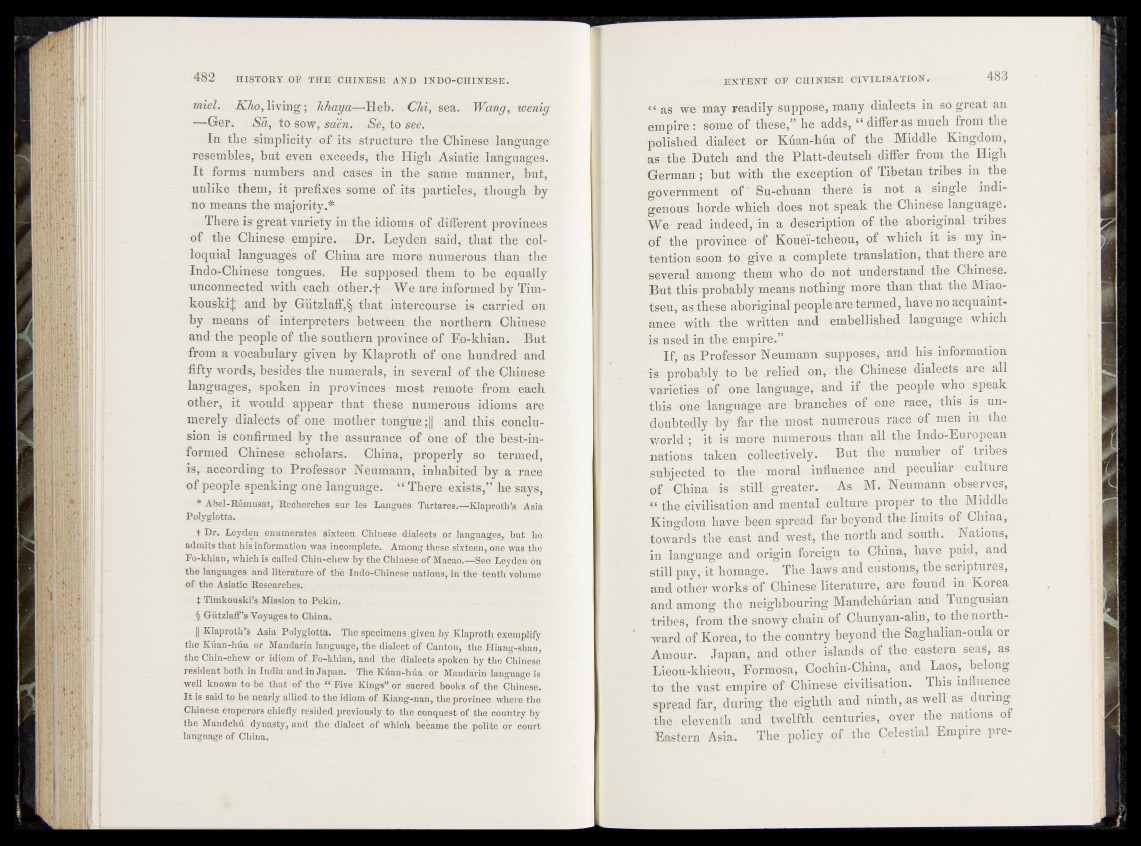
miel. Khof living; khaya*—Heb. CAi/ sea. Wang, wenig
~G er. • Sa, to sow, sain. Se, to see.
In the simplicity of its structure the Chinese language
resembles, but even exceeds, the High. Asiatic languages. ° O _ © It forms numbers and cases in the same manner, but,
unlike them, it prefixes some of its particles* though by
no means the majority.*
Thereis great variety in the idioms of different provinces
of the Chinese empire. Dr. Leyden said, that the colloquial
languages of China are more numerous than the
Indo-Chinese tongues. He supposed them to be equally
unconnected with each' other.f We are informed by Tim-
kouskij and by GutzlaJ0P,§ that intereoiirse is carried'son
by means of interpreters between the northern Chineae
and the people of the southern provincoof Fo-khian. But
from « vocabulary given by Klaproth of one bundred and
fifty words, besides the numerals, jn afevefcaj *$$.
languages, spoken in provinces - most remote from, each
other, it would appeaF that these numerous idioms are
merely dialects of one mother tongn©|§ and this conclusion
is confirmed by the assurance of one o f . the best-informed
Chinese scholars. . China,-properly p> termed^
is, according to Professor Neumann, inhabited by a race
of people speaking one language. u There exists,” fie says*
* Abel-Remusat, Reeherches sar les Latxgues Tartares.-—Klaprotb’s Asia
Polyglotta.
t Dr. Leyden enumerates sixteen. Chinese dialects languages, hat he
admits that his information was incomplete. Among these six^en^oge was. the
Fo-khian, which is called Chin-chew hy the Chinese of Macao.—See Leyden o |
the languages and literature of the Indo-Chinese nations, in the tenth vbhime
o f the Asiatic Researches.
t Hmkooski’s Mission to Pekin.
^{Jiitzlaff’s Voyages to China.
-Klaproth*« Asia Polyglotta. The specimens given by Klaproth exemplify
the Khan-hda or Mandarin language, the dialect of Canton, the Hiang-shan,
the CiKin-chew or idiom of Fo-khian, and the dialects spoken by the Chinese
resident both in India and in Japan. The Khan-hua or Mandarin language is
well known to be that of the “ Five Kings” or sacred books of the Chinese.
It is «ftid.to be nearly allied to the idiom of Kiang-nah, the province where the
Chinese emperors chiefly resided previously to the conquest of the country by
the Mandchti dynasty, and .the dialect of which became the polite or court
language of China.
“ as we may readily suppose, many dialects in so great an
empire : some of thesê,” he adds, “ differ as much from the
polished dialect or Kûan-hûa of the Middle Kingdom,
as th© Dutch and the Platt-deutseh differ from the High
German ; but with the exception of Tibetan tribes in the
government óf * Su-chuan there is not a single indigenous
horde which does riot speak, the Chinese language.
We read indeed, |B a description of thé aboriginal tribes
of the province of Koueï-tcheou, of which it is my intention
soon to give a complét’©? translation* that there are
several among them who- dp; not understand the Chinese.
But this probably means nothing more than that the Miao-
tseu, as these aboriginal people are termed, have no acquaintance
with thé written and embellished language which
-If, as Professor Neumann .supposes, and his information
is probably/to >be-relied on, the Chinese dialects are all
varieties” of one language,: and if the people who speak
this one larîguageare branches of o n e race, this is undoubtedly
:by far the most numerous rape of men in the
worldj^t^is more numerous than1 alfthpi Indo-European
uMions taken ïeolléêtivàyv But the number of tribes
subjected to the moral influence and peculiar culture
of < China is Still • greater As M. Neumann observes,
‘‘ the civilisation and mental culture proper to the Middle
Kingdom have been spread far beyond the limits of China,
towards the east and west, the north and south. Nations,
in language and origin foreign to China, have paid, and
still pay, it homage. The laws and customs, the scriptures*
and other works of Chinese literature, are found in Korea
and among the neighbouring Mandchurian and Tungusian
tribes, from the snowy chain of ChnnVan-alin, to the northward
of Korea, to the cofmtry beyond the SaghaliaH-oula or
Amour. Japan, and other island^ of the eastern sêas;, as
Lieou-khieou, Formosa, Cochin-China, and Laos, belong
to the vast empire of .Chinese civilisation. This influence
spread far, during the eighth and ninth, as well as during
the eleventh and twelfth centuries, over the nations of
Eastern Asia. The policy of the Celestial Empire pre